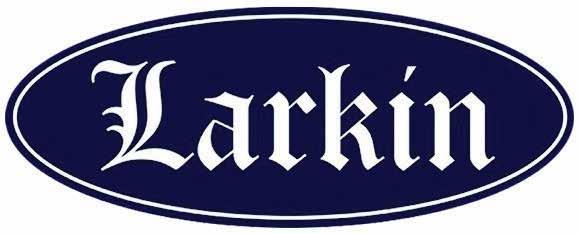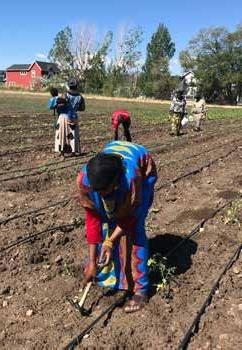
4 minute read
Lessen the chance that you outlive your
What’s your legacy?
Serving Local Families Since 1885

COMPASSIONATE FUNERAL PLANNERS During one of life’s most difficult moments, you deserve the utmost respect, kindness, care, and guidance. Six generations of Larkins have been devoted to serving Utah families in their time of need, and that unique experience enables us to guide you in preparing services for your loved one with consideration and respect.
4 LOCATIONS ACROSS THE WASATCH FRONT
Larkin Mortuary Larkin Sunset Lawn
260 East South Temple 2350 East 1300 South
Salt Lake City, UT 84111 Salt Lake City, UT 84108
(801) 363-5781 (801) 582-1582 Larkin Sunset Gardens Larkin Mortuary Riverton
1950 East Dimple Dell Road 3688 West 12600 South (10600 S.) • Sandy, UT 84092 Riverton, UT 84065 (801) 571-2771 (801) 254-4850
www.LarkinCares.com
Refugees establish new roots through farming
By Stephanie Yrungaray | s.yrungaray@mycityjournals.com
Dressed in a colorful baati and black head covering, Fahmo Abdullhi hacks away at weeds. As she works, few people probably notice the 13 acres of farmland tucked be- tween a park, a community garden and a busy road in Draper. But for Abdullhi and 35 other farmers from Sudan, Burma, Bhutan, Chad, Somalia and Burundi, this field is sprouting crops that signify independence, community and hope for the future.
The field is part of New Roots, a pro- gram run by the International Rescue Com- mittee (IRC) in cooperation with Wasatch Community Gardens. One of several pro- grams created to help the estimated 60,000 refugees in Utah adjust and thrive to life in the United States, it is a unique way for refu- gees to add supplementary income and learn about running an agricultural business.
A refugee from Somalia, Abdullhi has lived in Utah for four years with her husband and 7-year-old daughter. She started with a smaller garden plot in the New Roots West Valley location—just northeast of the Red- wood Recreation Center—and now has two 200-foot long beds. As the refugee farmers learn more and if they have a desire to grow more crops, they are moved to a larger mi- cro-training farm space in Draper. The Drap- er micro-training farm is home to the more advanced farmers and provides space from the size of Abdullhi’s plot, to as many as five acres for refugees.
“Before they bring me a little garden, not the big one, for two years. They said if you like it you can come [to the micro-training farm],” Abdullhi said. “Every week I come two days, every time I have time I come.”
Abdullhi, who also does work as a housekeeper, drives an hour each way to tend to her crops. Her rows are planted with kale, serrano peppers, beans and corn, but over 100 different crops are grown in these mi- cro-training farms including tomatoes, car- rots, spinach, squash, potatoes, green beans and pumpkins. Some of Abdullhi’s produce will be used by her own family and the rest will be sold with the help of the IRC.
“Essentially we support refugee farmers in starting and maintaining small farm-based businesses,” said James Hunter, New Roots program manager for the IRC. “We provide training, technical assistance, access to seeds and supplies, a lot of training and best prac- tices for growing crops in northern Utah and marketing support to assist refugees in con- necting their products to market.”
The IRC runs three farmer’s markets where refugees can sell their crops. They also have contracts to provide produce to whole- salers, restaurants, school districts, cafeterias, restaurants, and even a salsa manufacturer in New York. Additionally, refugees can sell their produce through the New Roots pro-
In the foreground, Somalian refugee Fahmo Abdullhi tends to her crops at a New Roots micro farm in Drap- er. (Stephanie Yrungaray/City Journals)

duce subscription box that distributes a box of produce every week during the summer to 150 people.
Abdullhi said she likes growing food. Hunter said the micro-training farm program has many benefits for refugees.
“There is the revenue component of pro- viding supplementary or primary income for themselves and their family, but it also helps with their connection to the community,” Hunter said. “There are a lot of really incred- ible social and psycho-emotional benefits of being outside and working on the land.”
The coronavirus pandemic has had an impact on the program. Hunter said they are still navigating how to proceed with farmer’s markets but there are other ways people can support the program.
“Typically we would say to support the New Roots program by buying produce, but monetary support is always appreciated,” Hunter said. “We keep a running Amazon wish list for in-kind supplies. (Amazon Wish List - New Roots SLC) Most volunteer sup- port opportunities are on hold due to COVID to ensure the safety of our farmers and staff, but hopefully, once the pandemic subsides we will be back to having regular volunteer days. We love group volunteers.”
More information including the location of the farmer’s markets can be found at the New Roots SLC website.
You can donate here at help.rescue.org. And learn more about volunteering here at rescue.org/volunteer-opportunities/saltlake-city-ut. l





